Intro to structural Bio - slide 2
1/106
Earn XP
Description and Tags
focus on Nucleic acids; taught by Dr. N. Ramasubbu; about 50 mins long
Name | Mastery | Learn | Test | Matching | Spaced |
|---|
No study sessions yet.
107 Terms
DNA stands for
Deoxyribonucleic acid
RNA stands for
Ribonucleic acid
what are the building blocks for DNA and RNA?
nucleotides
what are nucleotides composed of?
base
sugar
phosphate
bases can be?
purine or pyrimidine
sugar can be?
ribose or deoxyribose
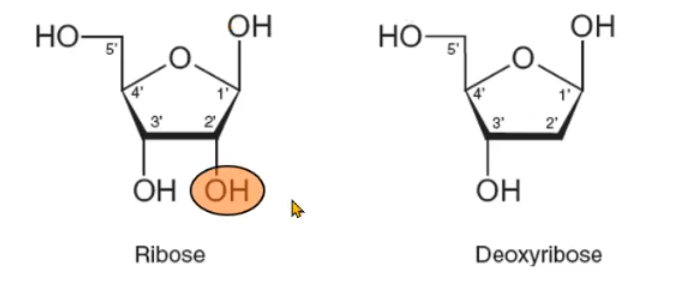
what are purines?
Adenine and Guanine
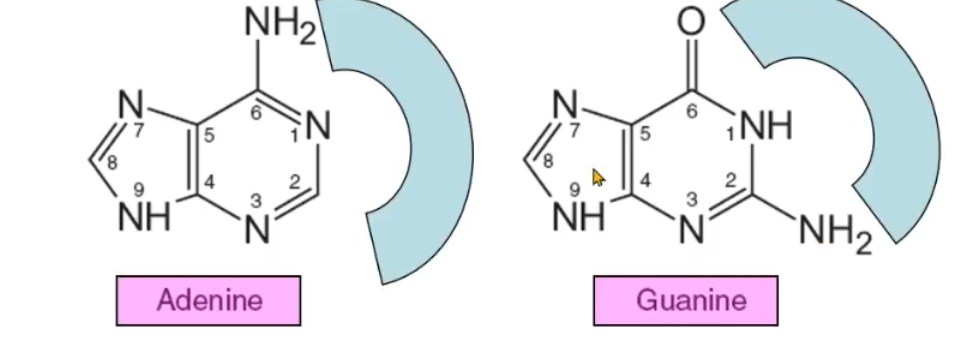
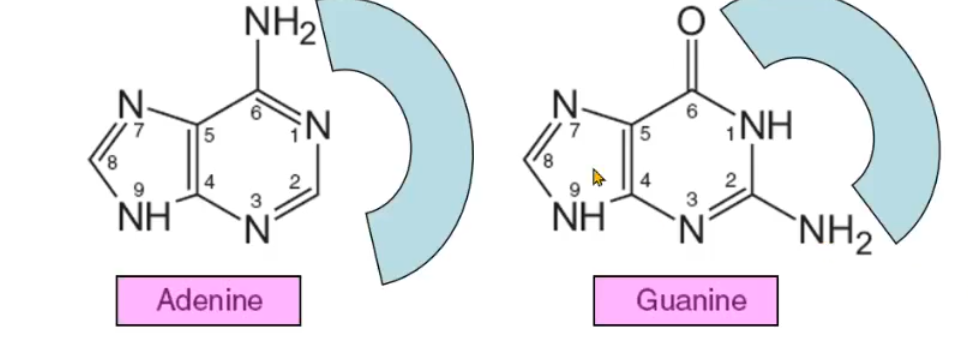
what are the thick blue/orange lines representing?
the space that contains the hydrogen binding information
what are pyrimidines
Uracil, Thymine Cytosine

what is the difference between thymine and uracil?
thymine has an methyl group at the 5th position

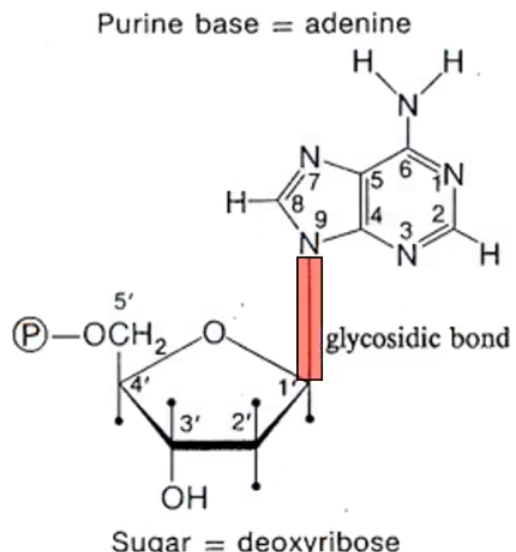
what is this highlighted portion representing?
the glycosidic bond, which connects base and sugar
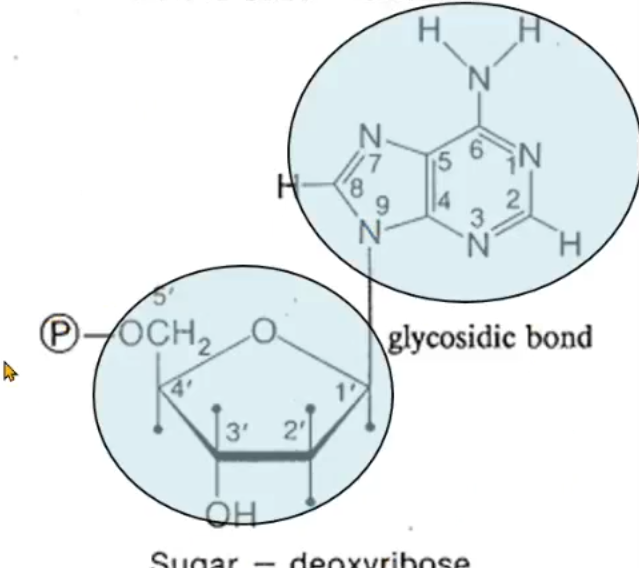
what is this highlighted portion representing?
A nucleoside, which contains the base and a sugar; e.g. adenine and a deoxyribose = adenosine
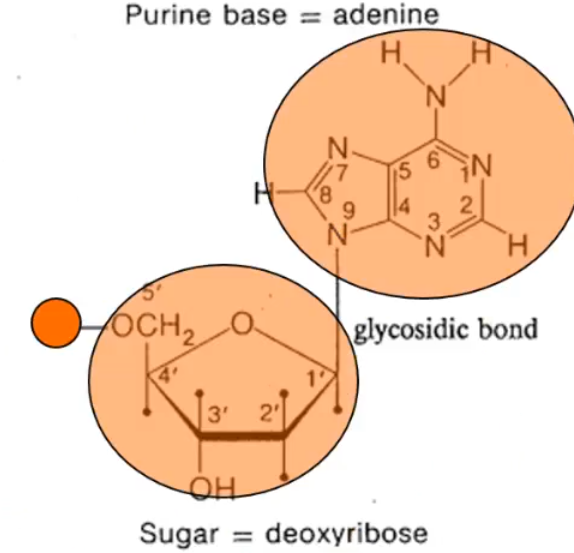
what is this highlighted portion representing?
A nucleotide, which contains the nucleoside and a phosphate

what is this structure representing?
ATP
how much energy is released when ATP is converted to ADP?
7kcals
what are the conformations of a nucleotide?
Anti or Syn
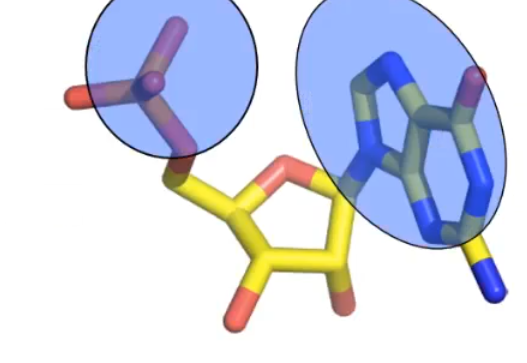
this represents what nucleotide conformation?
anti, facing away from each other, base pairing possible in DNA
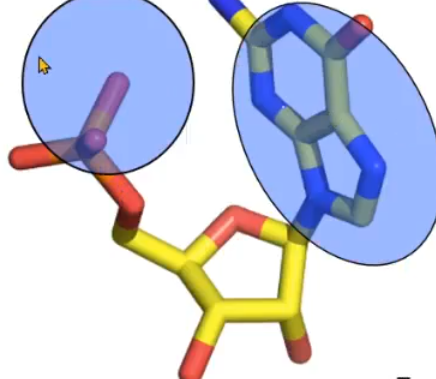
this represents what nucleotide conformation?
syn, facing towards each other; base pairing is not possible since it is facing into the double helix
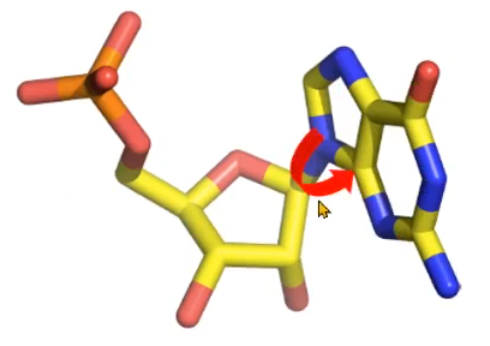
what is this arrow showing on the sturcure
it is showing the glycosidic bond and how it can rotate the conformation allowing for swapping between anti and syn
how was the structure of DNA deduced(discovered)?
Rosalind Franklins X-ray picture; showed base stacking from the black lines and because of the X shape were able to uncover that DNA is helical in nature
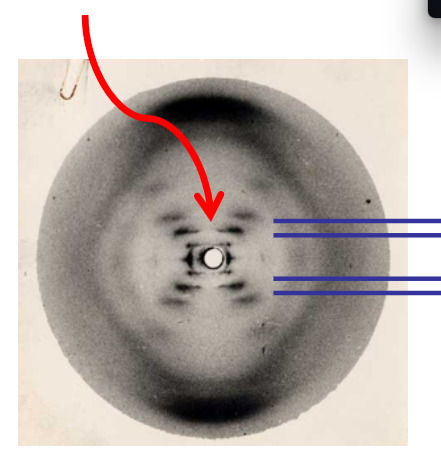
chargaff’s rules
%A = %T and %G = %C
Jerry Donahue’s contribution
showed the correct tautomer for hydrogen bonding atom
Linus Pauling’s dilemma?
it was whether to have the phosphate on the inside or outside of the structure model and how many strands their were in DNA
what are Tautomer’s of bases?
structural isomers of nucleic acid bases that differ in the arrangement of protons and double bonds
what is the main tautomer of cytosine?
the amino form; imino is also present
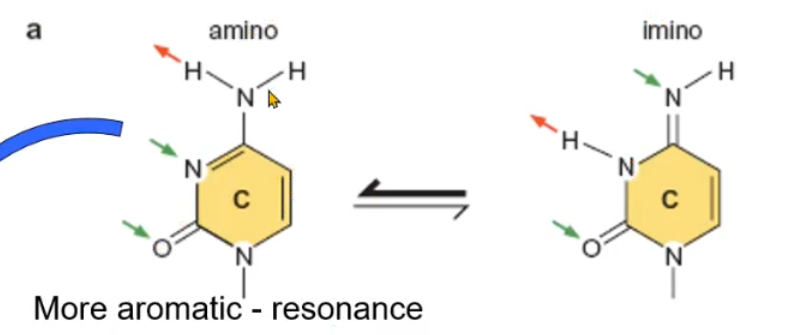
what is the amino form the major tautomer for cytosine?
because it is more aromatic - resonance, more stable
what is the main tautomer of Guanine?
the keto form; enol is also present
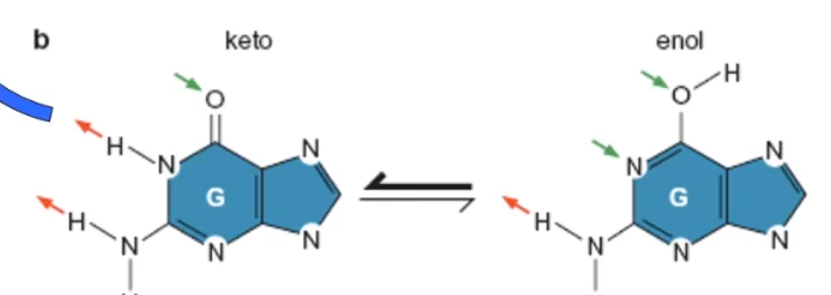
what is the keto form the major tautomer for guanine?
because it is more aromatic - resonance, more stable
what allows guanine and cytosine to be able to bind with each other?
the fact that the keto form in guanine and the amino form in cytosine are complementary and allow hydrogen bonding
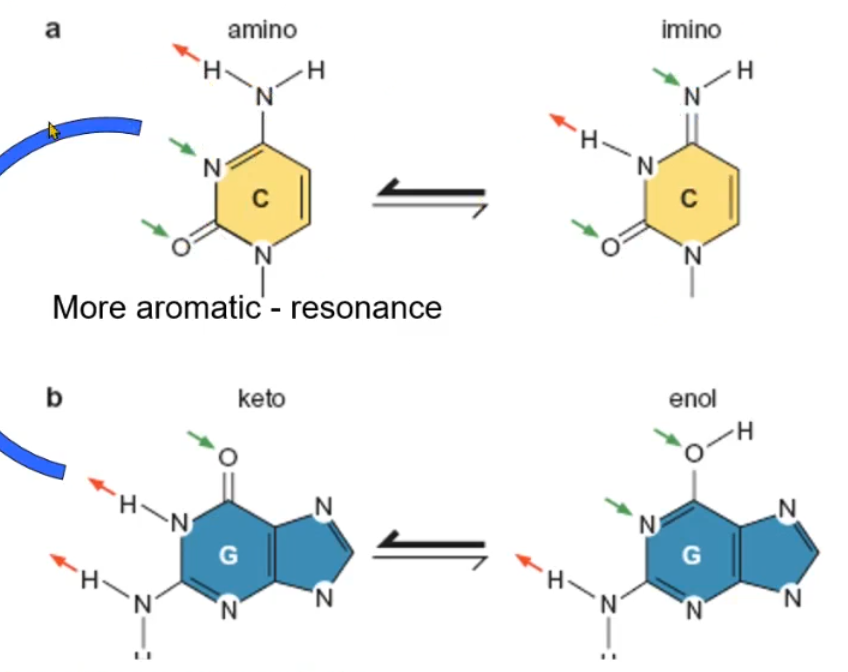
what do the red and green arrows represent in the diagram?
red- donors, green - acceptors
why are tautomer’s of bases important?
this information was important for Watson and Crick to create the DNA structure which become obvious after knowing that the correct tautomer’s of bases resulted in complementary pairing of GC and AT and bc of chargaff’s rule
what was the reason that 2 strands were originally represented for DNA?
They was no clear experimental data but crick suggested that nature always comes in pairs
what happens when a purine and purine exist next to each other and try to form a hydrogen bond pair?
there could be bonding, but bulging will occur, meaning:
base pairing rules violated
Disruption of the DNA structure - from bulge
Errors - replication and transcription
Introduced mutation affects organism
DNA width affected - from bulge
why cant A-C or G-T base pairs be formed?
It is possible, but then only 1 hydrogen bond will be formed(bottom), middle are 2 acceptors, top is 2 donor hydrogens bumping into each other
Hydrogen bond donors and acceptors would be incompatible
No hydrogen bonds could occur between the two
Unable to form maximum number of H bonds
Spatial constraint exists
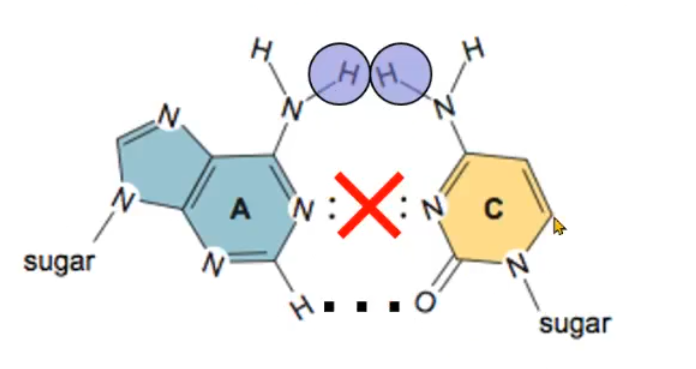
how can A-C or G-T base pairs be feasible?
If tatuomer’s are considered, however, the system has to be in the lowest energy state, this means that the amino form (in the examples of cytosine) is always preferred since it is at a lower energy state - more stable
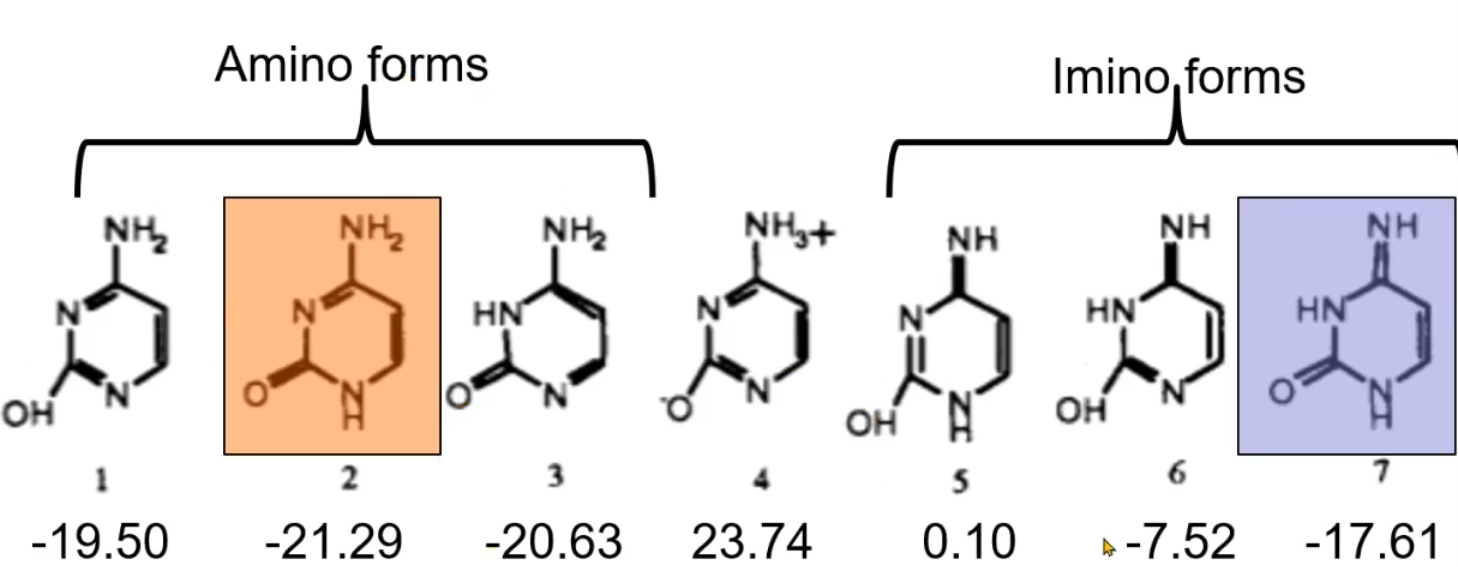
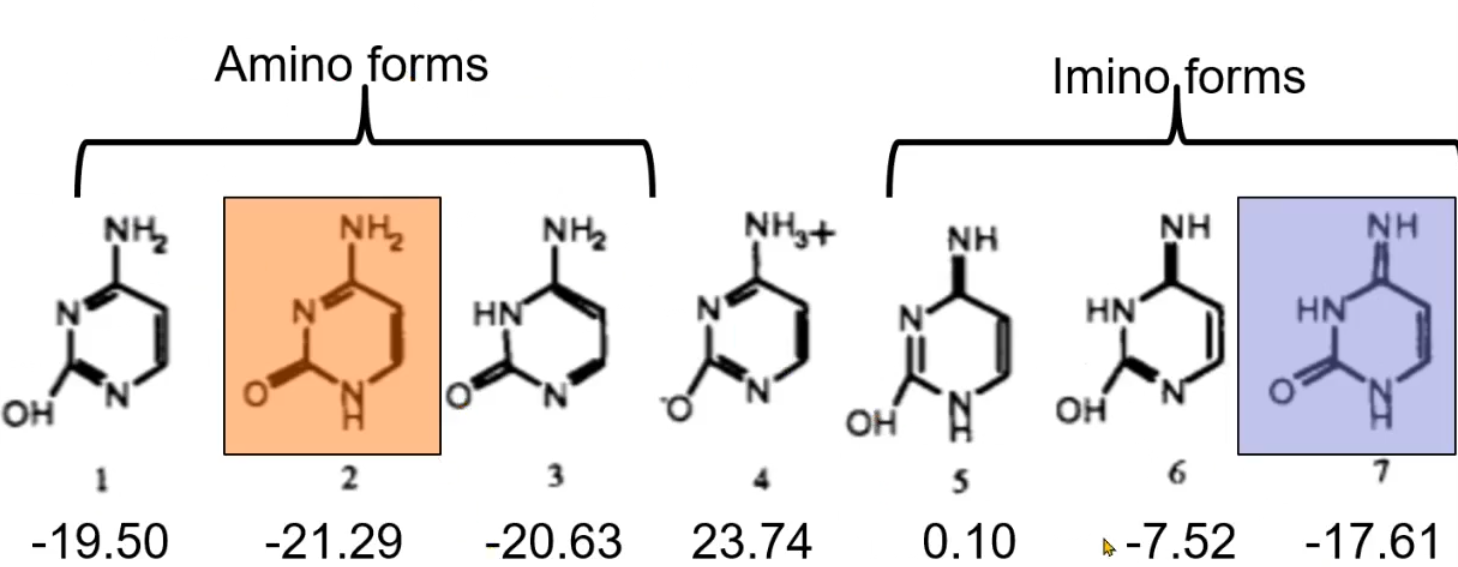
what does this represent?
It shows y the amino form is preferred and is always used in cytosine and it is because the amino form is at a lower energy state and in turn more stable
What is the structural benefit of having A:T and G:C pairing?
It is the regular structure
compatible hydrogen bonding
more symmetric in nature
Energetically favorable
how many hydrogen bonds do GC pairs form?
3 hydrogen bonds
how many hydrogen bonds do AT pairs form?
2 hydrogen bonds
where is the major groove on the DNA and what does it allow it to do?
It is on the outside, exposed side, of the DNA and allows for proteins to bind to it
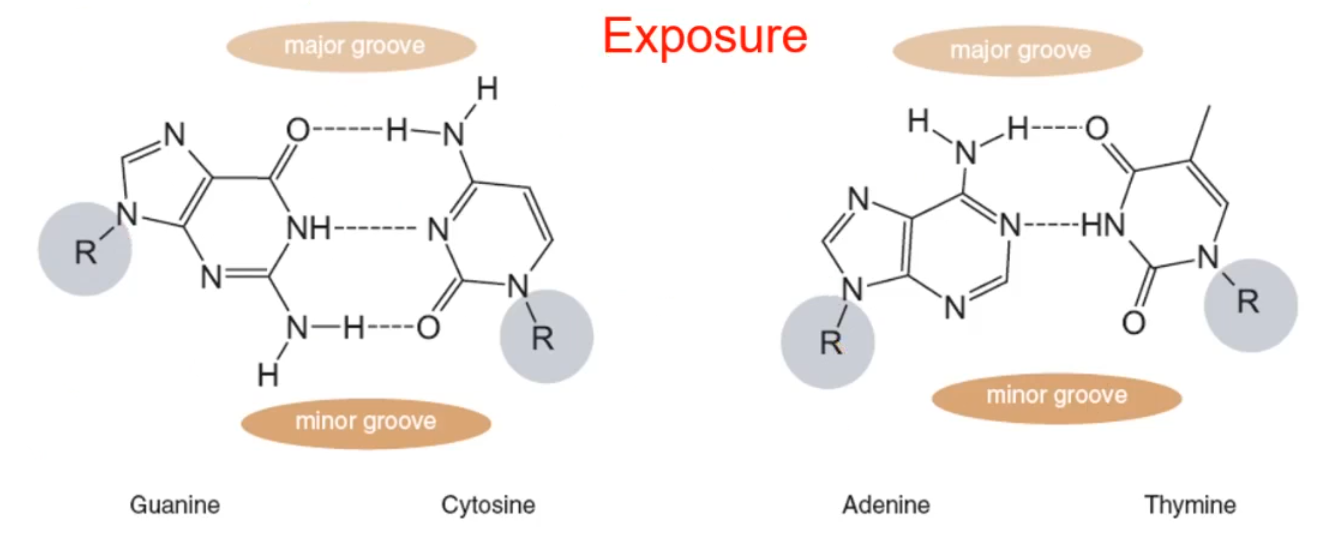
where is the minor groove on the DNA and what does it allow it to do?
it is on the inside of the DNA, since the location is bent, it does not allow for binding, very little space
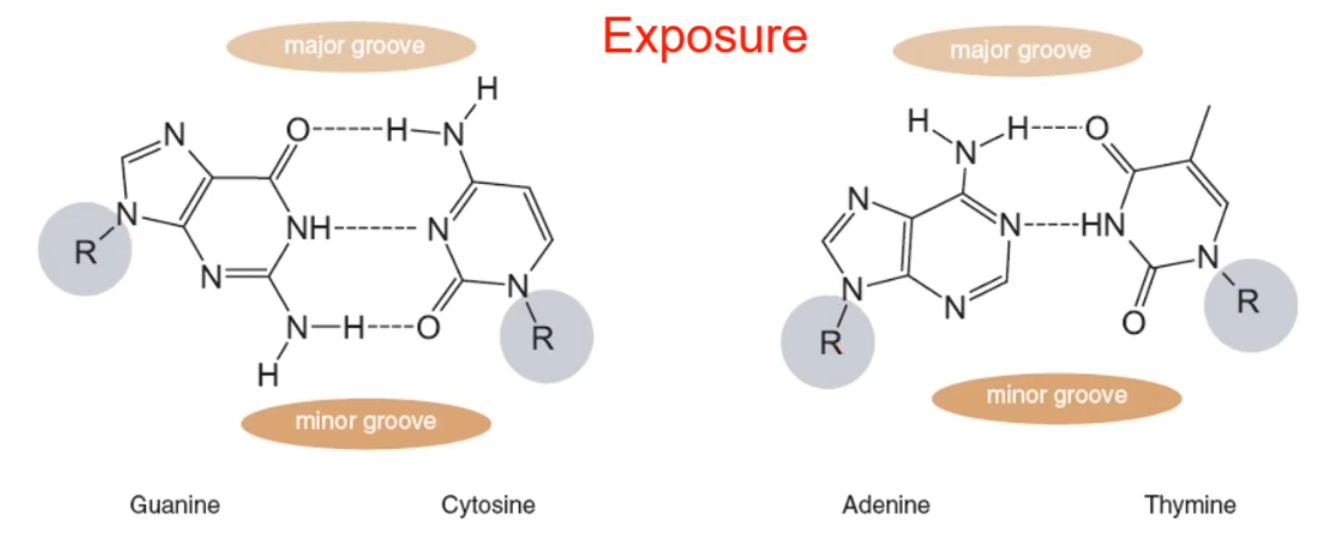
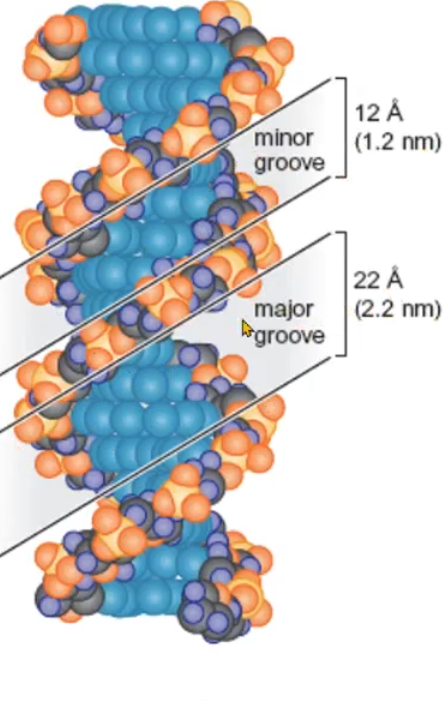
what does this diagram show?
it shows the minor and major grooves in a DNA molecule and the space difference between the 2 explaining why one is more favorable for binding than the other

What is the sequence of the antisense stand?
3`-TACGCGATCAGT-5` - antisense
what is another form DNA can take the shape of?
Ladder structure
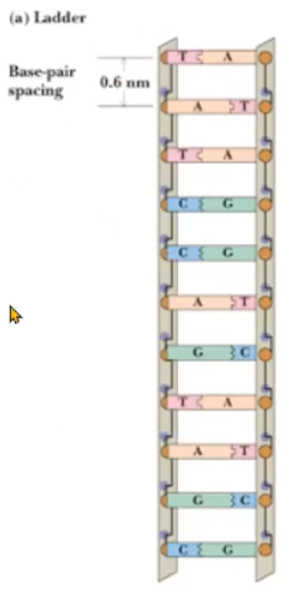
Why do nucleic acids form a helix and not the other structure?
Ladder structure - the distance between base pairs is 6 A where in a helix it is 3.4 A which allows water to pass through the space in a ladder structure; water will destabilize the base pairing; helix is closer tg excluding water from hydrophobic bases
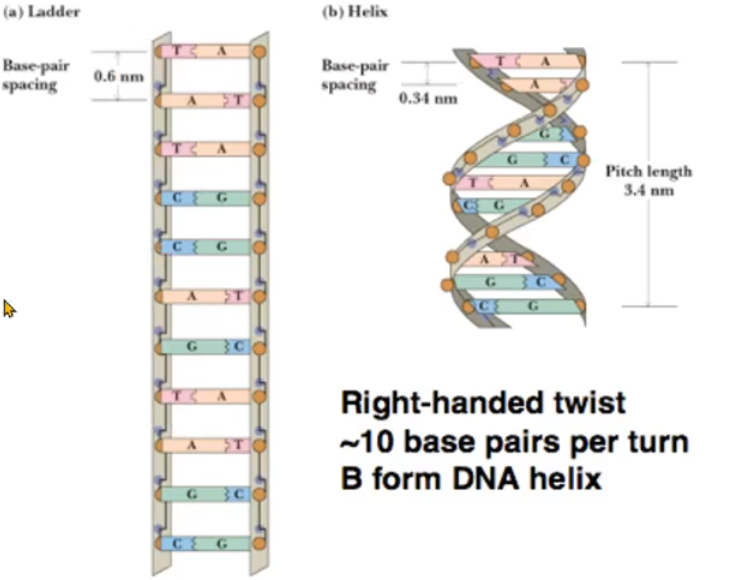
what holds the helix?
phosphates being outside
interaction with water
less repulsion
Bases inside
stacking
hydrogen bonding
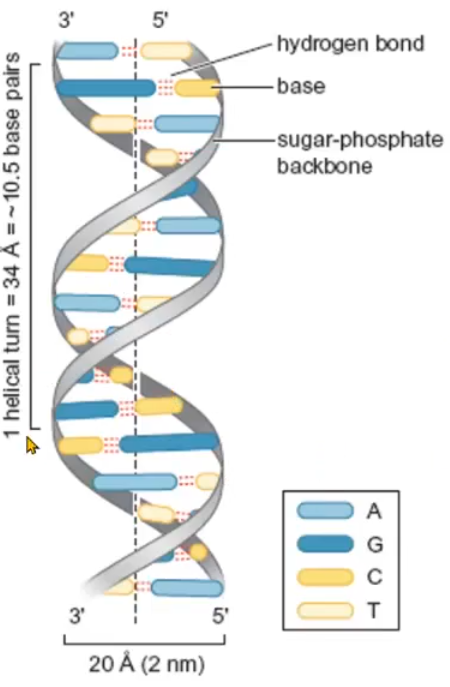
Major and minor grooves - why do we have them?
because of the attachment of bases to sugar is asymmetrical, this results in the minor and major grooves forming, if the attachment was straight, they would not form

what is the role of the major groove?
Depending on whether the binding of pairs is G-C or C-G, the major groove will be different and allows for identification based on the acceptors and donors that are exposed and in what order. This allows for specific bindings to the DNA and allowing the substance binding to distinguish between a G-C pair and a C-G pair
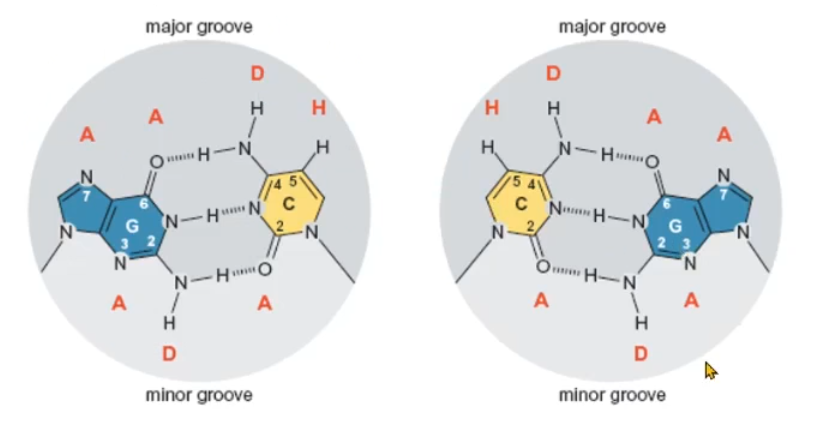
in basic terms, why is the major groove better for binding?
more info, can differentiate between, for example, C-G and G-C
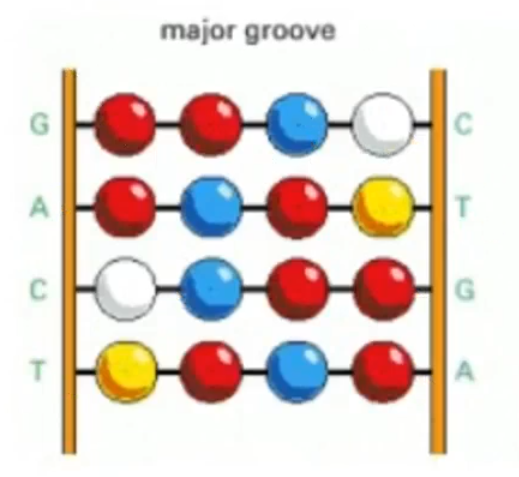
why does the minor groove not play the same role as the major groove in bind (other then all the other issues in stability and space)?
The sequence of acceptors and donors that is normal different on the major groove is the same in the minor groove, not allowing for differentiation between C-G pair and G-C pair (as an example)
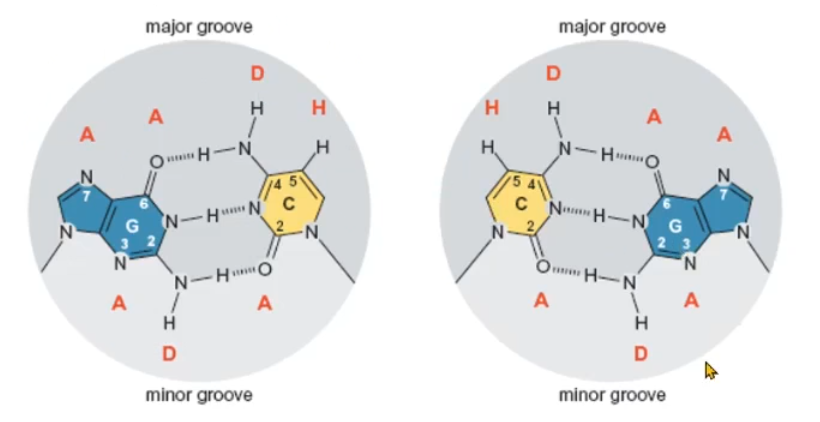
in basic terms, why is the minor groove worse for binding?
less info, can’t differentiate between, for example, C-G and G-C
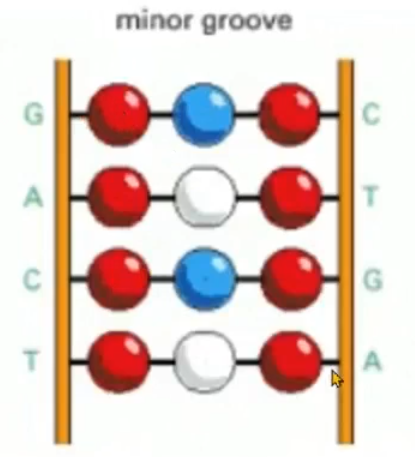
DNA structure and discovery summery
‘base pairs’ arise from hydrogen bonds
Erwin Chargaff had the pairing data, but didn’t understand its implications
Rosalind Franklin’s X-ray fiber diffraction data was crucial
Francis Crick showed that it was a helix
James Watson figured out the H bonds (Donohue)
The hydrophobic effect from stacking of aromatic bases is also important
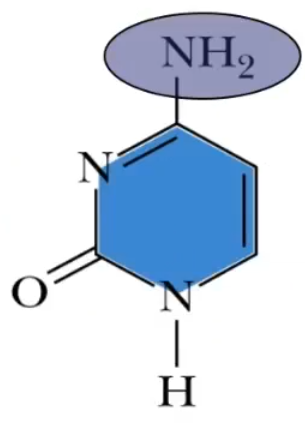
This is the structure of?
Cytosine
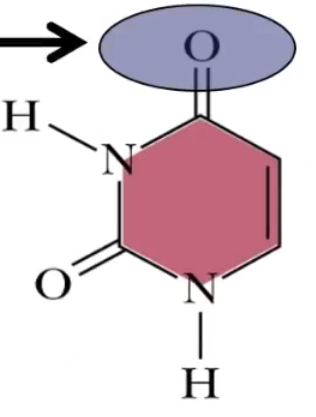
This is the structure of?
Uracil
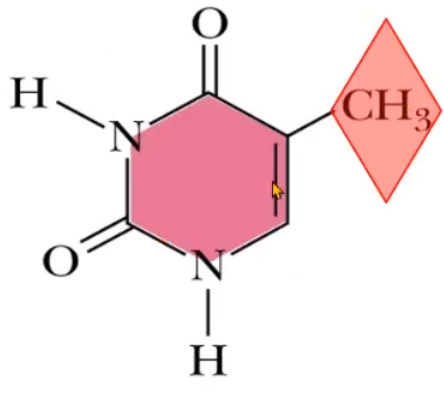
This is the structure of?
Thymine
what happens to cytosine spontaneously in DNA?
it spontaneously converts into Uracil
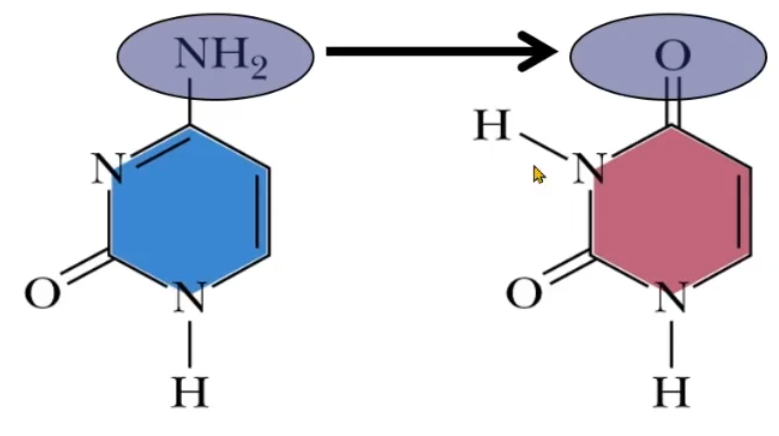
What happens when DNA enzymes detect the Uracil’s in DNA?
The repair enzymes recognizes them as mutations and replaces Us with Cs
If repair enzymes replace all Us with Cs, how would it distinguish between a legitimate U and mutant Us?
Thymine is used in place of uracil
what is another benefit of using Thymine in place of Uracil in DNA?
Thymine is more stable than Uracil, which makes it more suitable in DNA since is it needs to be long-lived, in comparison to RNA which is short-living
what is the name of the repair enzyme that converts the Us to Cs?
Uracil DNA Glycosylase (UDG)
why does RNA have uracil?
mRNA is short lived
more of it is produced - continuous production
Mutations (about 100 - 1000 per cell per day) are tolerated
Evolutionary RNA polymerases need not compete with DNA polymerase
what is a common modification of cytosine in DNA??
the methylation at position 5, usually clustered around protomers of genes in GC rich regions
what role does the methylation of position 5 in cytosine play?
regulation of gene expression
what happens structurally to a methylated cytosine?
it flips in out of helix and you lose a hydrogen bond
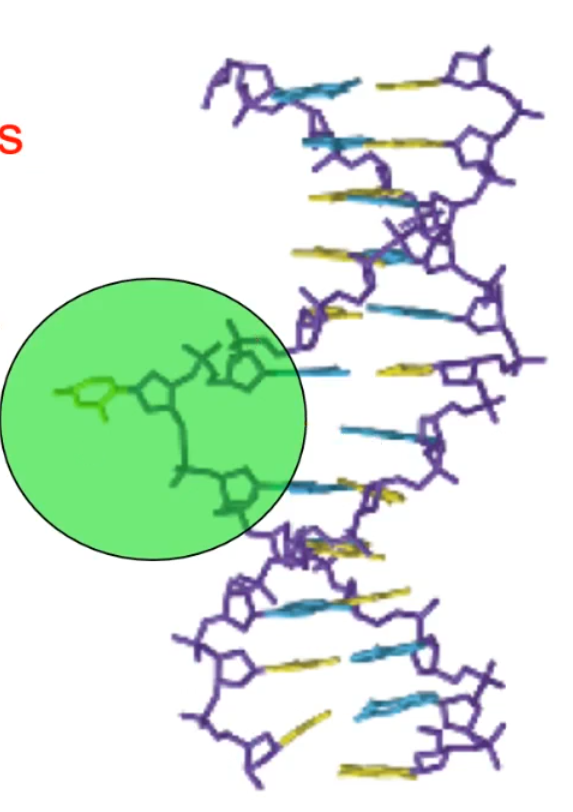
where does the flipping take place (major or minor groove)?
It can happen in both
can the flipped out bases (cytosine) be repaired of modified?
yes, they can be repaired/unmethylated
what enzyme causes the methylation of cytosine
methyltransferase
how can flipping be useful?
it can be useful for DNA repair
what are the 3 forms of DNA duplexes?
Form A
Form B
Form Z
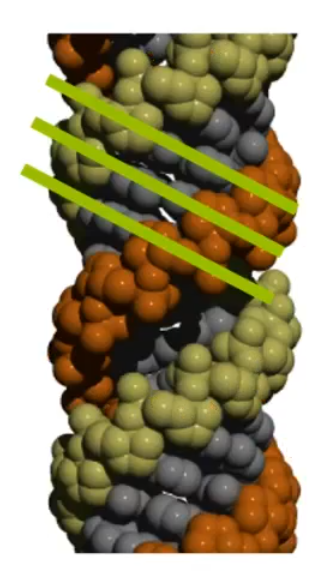
what form of DNA is this?
Form A
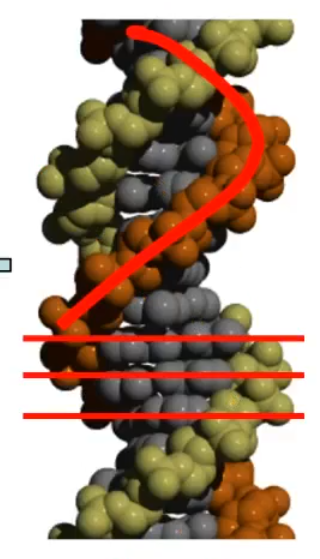
what form of DNA is this?
Form B
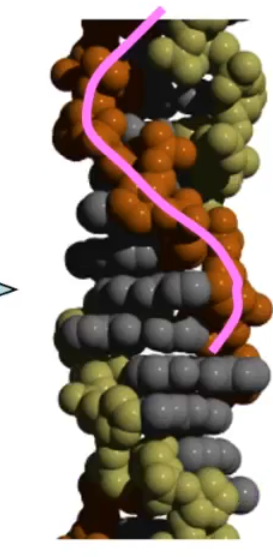
what form of DNA is this?
Form Z
what DNA form is the most abundant?
Form B
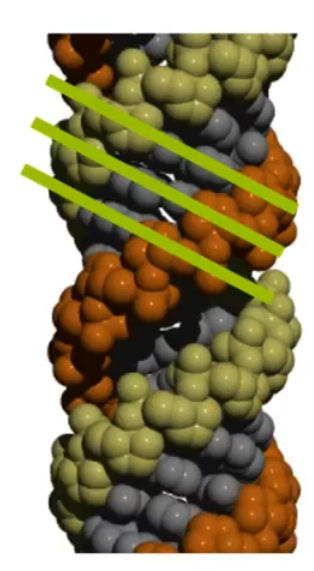
what are the details of form A?
High salt
minimal water
favored form for RNA
right handed helix
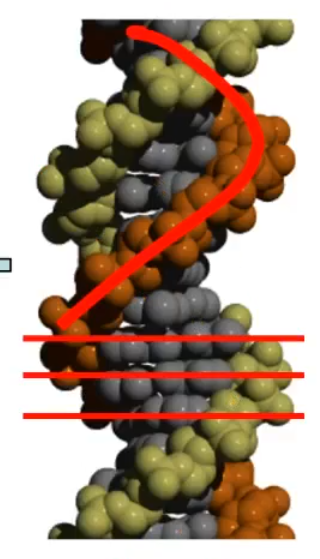
what are the details of form B?
Hydrated form
Right handed helix
will be more present in high water environments
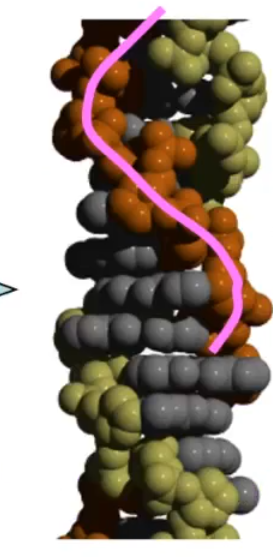
what are the details of form Z?
occurs mostly in alternating GCGCGC regions
Left handed helix
happens because of the glycosidic bond conformation changes (anti ⇌ syn)
has a zigzag form where C is in anti form and G is in syn form
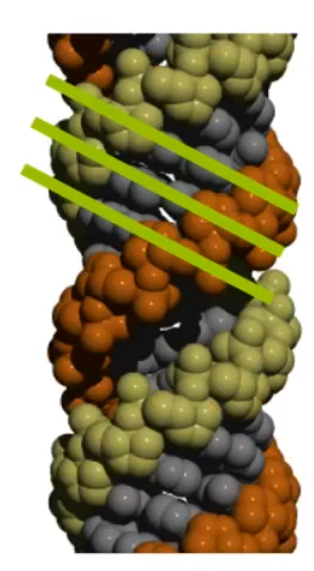
what do the green lines tell u in this picture?
It shows you how the base pairs are tilted
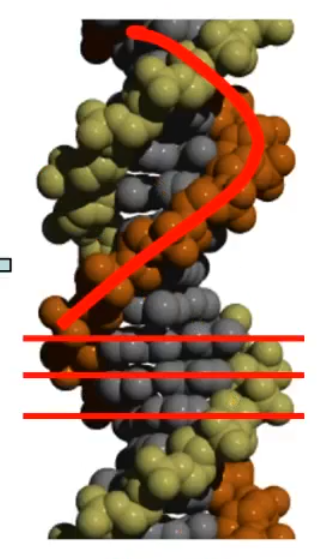
what do the red straight lines tell u in this picture?
it shows you how the bases are perpendicular to the helical axis
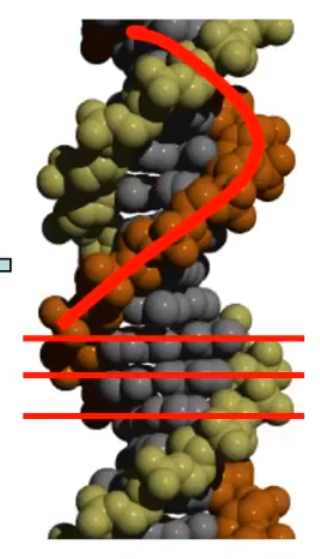
what does the solid spiral green line tell u in this picture?
It is representing the right handed helix that form B has
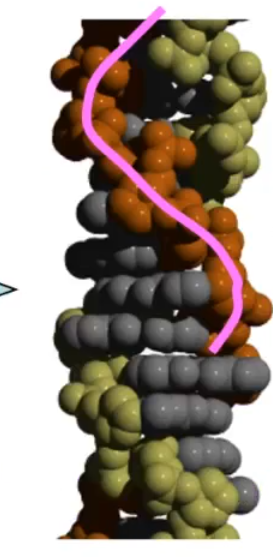
what does the solid spiral pink line tell u in this picture?
It is representing the left handed helix that form Z has
what is the favored duplex form of RNA?
Form A
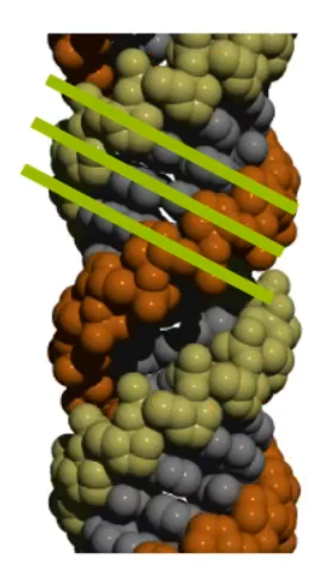
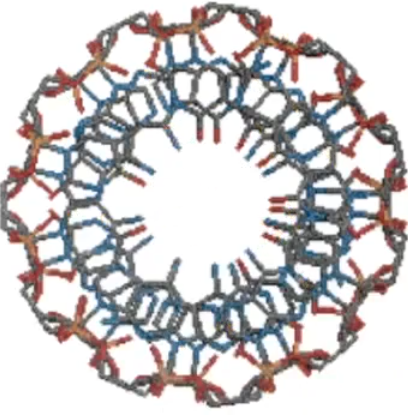
what DNA duplex is this the top structural of?
Form A, you can see how to helix is very wide and big
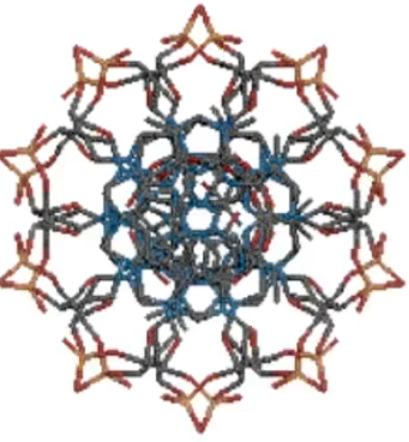
what DNA duplex is this the top structural of?
Form B, much more compact then form A
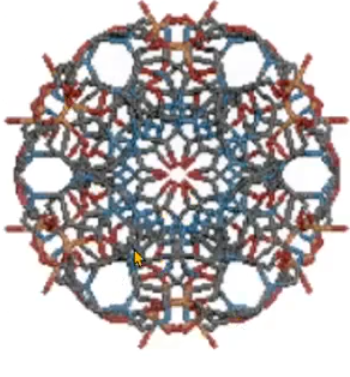
what DNA duplex is this the top structural of?
Form Z, can see the zigzag formation and how compact it is
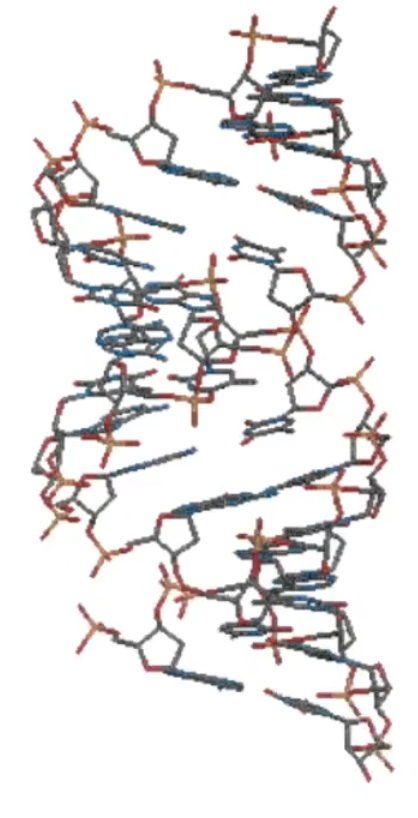
what DNA duplex is this the side structural of?
Form A, short, fat
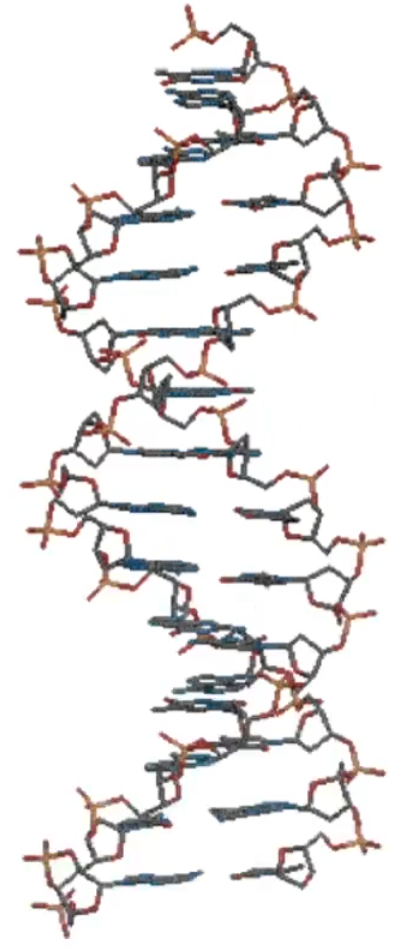
what DNA duplex is this the side structural of?
Form B
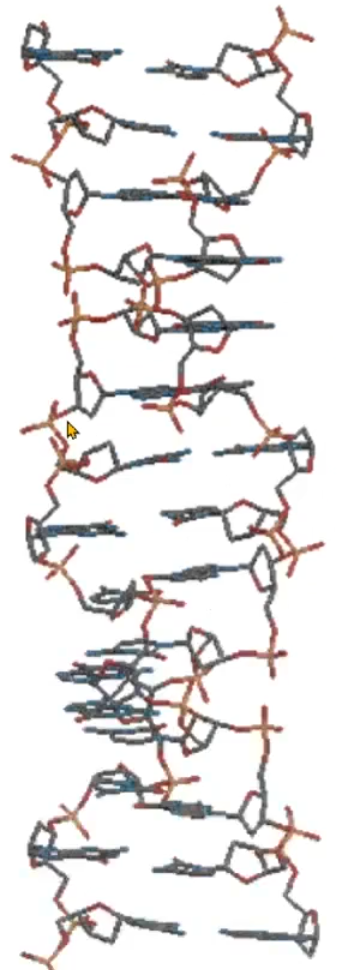
what DNA duplex is this the side structural of?
Form Z, stretched, thinner
what are characteristics of the major groove in the DNA duplex form A?
Narrow and deep
what are characteristics of the major groove in the DNA duplex form B?
Wide and deep
what are characteristics of the major groove in the DNA duplex form Z?
flat
what are characteristics of the minor groove in the DNA duplex form A?
Wide and shallow
what are characteristics of the minor groove in the DNA duplex form B?
Narrow and deep
what are characteristics of the minor groove in the DNA duplex form Z?
narrow and deep
How does the B to Z transformation occur?
there is a rotation of bases in a GC rich region of 180 degrees
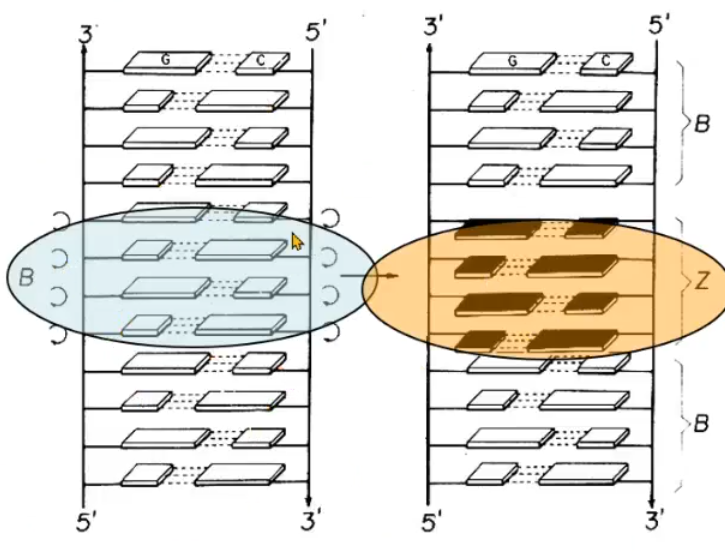
what is the physiological role of Z DNA?
transcription
relief of strain in supercoils
Transient in nature
Virus proteins can bind to prolong expression of antiapoptotic genes
what is present when a Z helix forms?
BZ junctions at the 2 ends of a Z helix
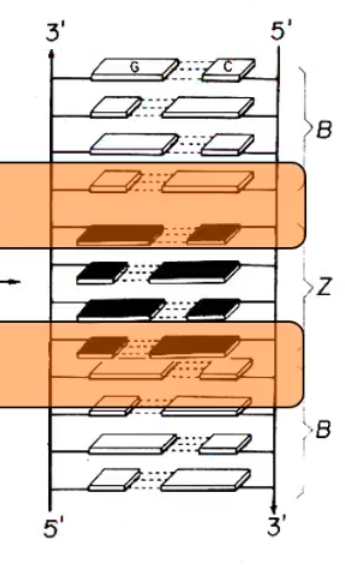
what happens to DNA when a protein binds?
It bends and makes a U-turn
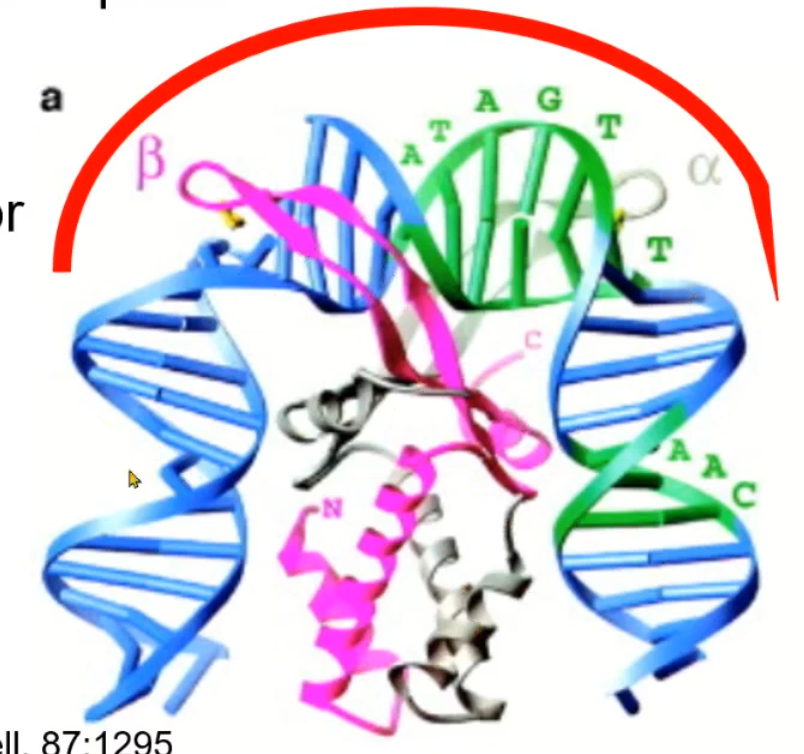
what does this represent?
the binding of a protein (Beta-sheet) to a DNA molecule it bending and making a U-turn
integration host factor (IHF)
protein that bends DNA to facilitate genetic processes such as replication, transcription, and recombination, and plays a crucial role in integrating viral or foreign DNA into the host genome
What is an example of a DNA binding protein?
TATA box binding protein (TBP) which binds to the TATA box (8 bp part of a promoter)
the protein has a saddle structure and binds to the minor groove